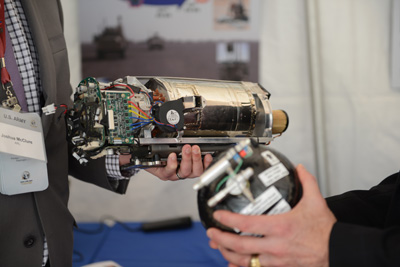By C. Todd Lopez
WASHINGTON (May 21, 2015) -- Batteries are heavy and don't provide enough power to give unmanned aerial systems the long loiter time that Soldiers could benefit from.
At the DOD Lab Day, May 14 at the Pentagon, Edward C. Shaffer, a researcher at Army Research Laboratory in Adelphi, Maryland, explained how a fuel cell, rather than a battery, is now extending the range of the Stalker XE UAS in Afghanistan.

"Without the fuel cell it runs on a battery," Shaffer said. "It runs for an hour. With the fuel cell on the UAS, it'll run up to 8 hours, without recharging or landing."
Fuel cells take a fuel -- such as propane -- and convert it to electricity without mechanical motion. It consumes fuel and oxygen, and produces water and carbon dioxide.
Shaffer had a fuel cell with him at the Pentagon which is similar to the one used in the Stalker XE UAS. He said in Afghanistan, the fuel cell-powered UAS has been on over 80 missions.
"The reason why we developed this is so we could provide that aerial system with prolonged duration, to increase the range of what they see, so they can cover their patrol, their convoy and their base. And it gives them that defensive situational awareness."
The fuel cell in the Stalker XE UAS runs on propane, but Joshua P. McClure, a chemical engineer at ARL, said they hope to develop fuel cells that run on fuels like JP8, which are more common in the Army logistics inventory.
He said right now, if a Soldier places JP8 into a fuel cell "it would die in a matter of minutes. The reason why is because of the sulfur impurities."
"Our primary focus for the future is we are developing new types of fuel cells," Shaffer said. "We are trying to move toward logistics fuels. We want to move toward increasingly more complex fuels -- like JP8."